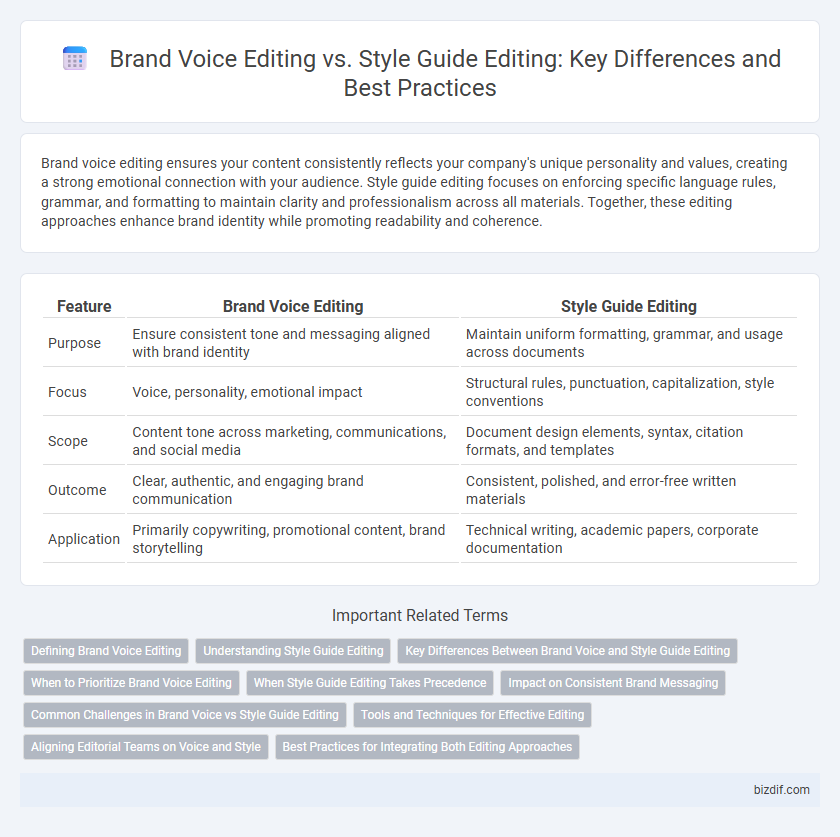Brand voice editing ensures your content consistently reflects your company's unique personality and values, creating a strong emotional connection with your audience. Style guide editing focuses on enforcing specific language rules, grammar, and formatting to maintain clarity and professionalism across all materials. Together, these editing approaches enhance brand identity while promoting readability and coherence.
Table of Comparison
| Feature | Brand Voice Editing | Style Guide Editing |
|---|---|---|
| Purpose | Ensure consistent tone and messaging aligned with brand identity | Maintain uniform formatting, grammar, and usage across documents |
| Focus | Voice, personality, emotional impact | Structural rules, punctuation, capitalization, style conventions |
| Scope | Content tone across marketing, communications, and social media | Document design elements, syntax, citation formats, and templates |
| Outcome | Clear, authentic, and engaging brand communication | Consistent, polished, and error-free written materials |
| Application | Primarily copywriting, promotional content, brand storytelling | Technical writing, academic papers, corporate documentation |
Defining Brand Voice Editing
Brand voice editing focuses on shaping a consistent tone, personality, and emotional impact that reflects a brand's identity across all content platforms. It ensures that messaging resonates authentically with the target audience by aligning language, vocabulary, and style with the brand's core values and mission. This process differs from style guide editing, which primarily standardizes grammar, punctuation, and formatting rules to maintain coherence and professionalism.
Understanding Style Guide Editing
Style guide editing ensures consistency by adhering to predefined rules for grammar, punctuation, and formatting across all content. It involves applying specific standards from brand or industry style manuals to maintain uniformity in language and presentation. Mastery of style guide editing enhances clarity, professionalism, and cohesiveness in written communication.
Key Differences Between Brand Voice and Style Guide Editing
Brand voice editing centers on maintaining a consistent tone, personality, and emotional connection that reflects the brand's identity, ensuring all communication resonates with the target audience. Style guide editing focuses on enforcing specific rules for grammar, punctuation, formatting, and language usage to create uniformity and professionalism across all content. The key difference lies in brand voice editing shaping how the brand speaks, while style guide editing ensures the technical correctness and consistency of that speech.
When to Prioritize Brand Voice Editing
Brand voice editing should be prioritized when maintaining a consistent emotional tone and personality across all communication channels is crucial for brand identity. This process ensures that messaging resonates authentically with the target audience, strengthening brand recognition and loyalty. Style guide editing, on the other hand, addresses adherence to grammatical rules, formatting, and language conventions but does not influence the overall voice or emotional impact of the content.
When Style Guide Editing Takes Precedence
When Style Guide Editing takes precedence, the emphasis lies on ensuring consistency and adherence to established language rules across all content. This editing process rigorously enforces grammar, punctuation, and formatting standards defined by the organization's style manual. Brand Voice Editing becomes secondary to maintain uniformity that supports clear, professional communication aligned with the company's documented style preferences.
Impact on Consistent Brand Messaging
Brand voice editing ensures that every piece of content reflects the unique personality and tone of the brand, fostering emotional connections with the audience and reinforcing brand loyalty. Style guide editing maintains uniformity in grammar, punctuation, formatting, and terminology, which supports clarity and professionalism across all communications. Together, these editing practices maximize consistent brand messaging by aligning both the emotional and technical elements of content.
Common Challenges in Brand Voice vs Style Guide Editing
Brand voice editing often struggles with maintaining consistent tone and emotional resonance across diverse content, while style guide editing faces challenges in enforcing uniform grammar, punctuation, and formatting rules. Ensuring that brand voice reflects evolving company values without losing authenticity frequently conflicts with rigid style guidelines. Balancing creative expression in brand voice with the precision required by style guides remains a key common challenge.
Tools and Techniques for Effective Editing
Brand voice editing employs tools like tone analyzers and sentiment analysis software to ensure consistent personality across content, while style guide editing relies on grammar checkers and formatting tools to maintain adherence to established writing conventions. Techniques in brand voice editing emphasize alignment with audience perception and emotional resonance, utilizing linguistic pattern recognition; style guide editing focuses on rule-based correction and uniformity using automated template compliance checks. Effective editing integrates these tools and techniques to balance creativity with precision, ensuring both distinctive brand identity and clear, professional presentation.
Aligning Editorial Teams on Voice and Style
Brand voice editing ensures consistent tone, personality, and messaging that reflect the brand's identity across all content, while style guide editing enforces standardized grammar, punctuation, and formatting rules. Aligning editorial teams on both brand voice and style guide fosters cohesive communication, reduces inconsistencies, and enhances overall brand recognition. Clear guidelines on voice nuances and stylistic preferences empower editors to maintain uniformity and elevate the quality of all published materials.
Best Practices for Integrating Both Editing Approaches
Integrating Brand Voice Editing and Style Guide Editing requires aligning tone and consistency with established linguistic rules, ensuring content resonates authentically while maintaining clarity and professionalism. Best practices include collaborative development of a unified framework where brand personality traits are embedded within style guidelines, enabling editors to apply voice nuances without deviating from grammatical standards. Regular audits and cross-functional training help reinforce adherence, fostering seamless edits that strengthen brand identity and uphold stylistic integrity.
Brand Voice Editing vs Style Guide Editing Infographic

 bizdif.com
bizdif.com